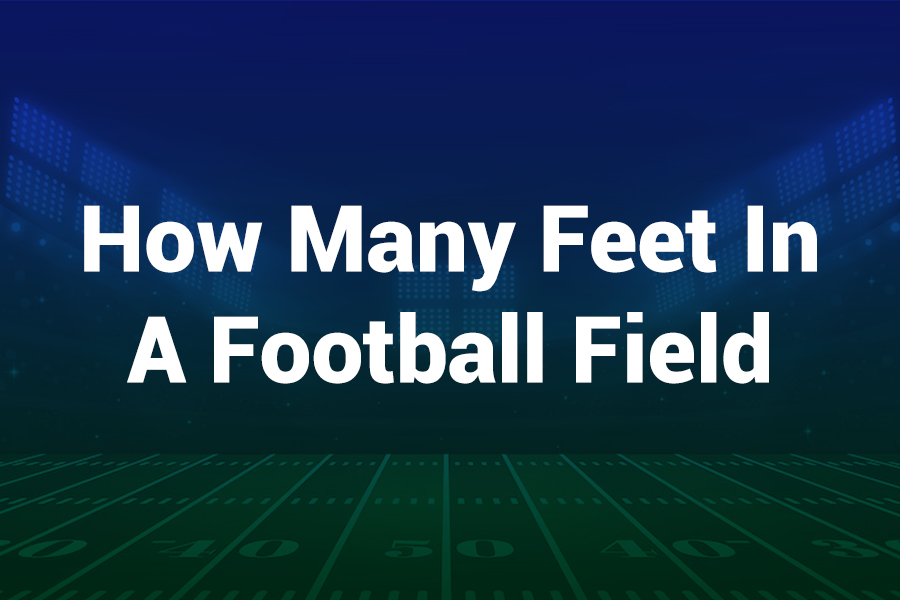A football field in the U.S. isn’t just “about 300 feet” — it has precise, fixed dimensions used in high school, college, and professional play.
In this article you will learn exactly how many feet long and wide a standard American football field is, the difference between the playing area and the full field, and common variations. You’ll also see helpful visuals and practical context to make it crystal clear — in this article.
Standard Length in Feet
A full American football field, measured from the back of one end zone to the back of the other, spans 360 feet. That’s because it covers 120 yards, and since one yard equals three feet, the conversion is:
120 yards × 3 = 360 feet
Within that 360 feet, the “field of play” — where most of the game action occurs — is 100 yards, which equals 300 feet. The extra 20 yards (10 yards on each end) are the two end zones. Thus:
- Field of play: 300 feet
- Two end zones combined: 60 feet
- Full length: 360 feet
Standard Width in Feet
From sideline to sideline, a regulation American football field is 160 feet wide. That corresponds to 53⅓ yards (53.333… yards), because:
53.333 yards × 3 = 160 feet
So the full dimensions are:
- Length: 360 feet
- Width: 160 feet
Field of Play vs. Full Field
It’s important to understand the distinction:
- Field of Play: 100 yards, or 300 feet, between the two goal lines.
- End Zones: Each team’s end zone adds 10 yards (30 feet) beyond their goal line.
- Total Length (goal line to goal line plus end zones): 120 yards (360 feet).
When someone casually asks “How many feet is a football field?” they may be referring to either the playing field portion (300 feet) or the full length (360 feet). In common usage, it’s often the full field length that’s meant.
Area in Square Feet and Acres
Knowing the dimensions in feet lets us calculate the area. Multiply length by width:
360 ft × 160 ft = 57,600 square feet
To put that in perspective, a football field covers approximately 1.32 acres, since one acre equals 43,560 square feet:
57,600 ÷ 43,560 ≈ 1.32 acres
Why Those Dimensions? A Short History
The dimensions weren’t always this way. Early American football borrowed from older rugby-style fields and evolved over time. In 1912 the forward pass was legalized, and end zones were added, raising the field length to its current standard. The width (160 feet) was fixed to match evolving play styles and stadium constraints.
Dimensions varied in the early era, but by the 1920s the 120-yard length became widespread. The 53⅓-yard width (160 feet) remains consistent across high school, college, and NFL play.
Markings, Lines, and Hash Marks
Beyond the outer edges, the field carries many lines and markings that also relate to feet and yards:
- Yard lines run every 5 yards (15 feet), across the width.
- Hash marks are shorter lines inside the field; their spacing differs by level:
- High school: 53 feet 4 inches apart
- College: 40 feet apart
- NFL: 18 feet 6 inches apart
- Goal posts: Crossbar is 10 feet above the ground. The uprights extend upward another 20+ feet depending on level. The width between uprights (college/NFL) is 18 feet 6 inches.
Variations at Different Levels
While the outer dimensions remain the same (360 × 160 feet), some components differ:
- Hash mark spacing (mentioned above)
- Youth fields: often scaled down (e.g. 60–80 yards in length)
- Indoor / Arena fields: drastically shorter and narrower — for example, arena football fields are about 200 feet long total with 8-yard end zones, far smaller than outdoor fields
Common Confusions
- When people say “a football field is 100 yards long,” they refer to just the central portion — the field of play.
- When someone asks “how many feet,” they may expect 300 feet, but the more precise “full length” is 360 feet.
- The width never changes in standard play.
Examples & Practical Uses
- If you want to draw a life-size layout in your backyard or track, you’d mark 360 feet in length and 160 feet width.
- To find area in acres, use the 57,600 square feet figure.
- For drills that span the entire field, coaches use 360 feet. For plays between goal lines, they use the 300-foot core field.
Why This Matters
Understanding these precise measurements matters for:
- Stadium and turf design
- Broadcast graphics
- Coaching and play design
- Comparisons with other sports fields (soccer, baseball, etc.)
Quick Summary Table
| Parameter | Measurement in Feet |
| Full field length | 360 ft |
| Field of play length | 300 ft |
| Width | 160 ft |
| Total area | 57,600 sq ft |
| Area in acres | ~1.32 acres |
Final Thoughts
So, to answer clearly: a standard American football field is 360 feet long, inclusive of both end zones, and 160 feet wide. The core field where play happens (between the goal lines) spans 300 feet in length.
Knowing these definitions ensures you always use the correct values in the right context — whether comparing with other sports, planning a layout, or discussing game strategy.

